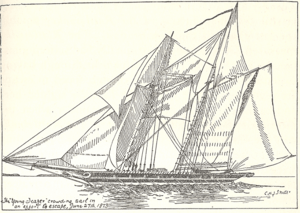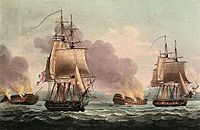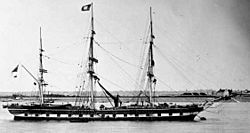Capture of the Young Teazer facts for kids

Young Teazer
|
|
Quick facts for kids History |
|
|---|---|
| Name | Young Teazer |
| Owner | Samuel Adams |
| Launched | 1813 |
| Commissioned | 3 May 1813 |
| Homeport | New York City |
| Fate | Destroyed in explosion 27 June 1813 after HMS Hogue and HMS Orpheus trapped her |
| General characteristics | |
| Type | Privateer |
| Tons burthen | 120 or 124 |
| Length | 60 ft (18 m) (overall) |
| Sail plan | Schooner |
| Complement | 65, or 73 |
| Armament | 5 guns plus 3 wooden dummy guns |
| Notes | Source for info box dimensions |
The Young Teazer was a fast American schooner ship. She was a privateer, which means she was a private ship allowed by the government to attack enemy ships during wartime. During the War of 1812, the Young Teazer captured 12 British ships. Five of these ships were successfully taken to American ports.
The Young Teazer became famous for a dramatic explosion. A member of her crew blew her up at Mahone Bay, Nova Scotia. This happened after British warships, including HMS Hogue, chased and trapped her. The explosion killed most of her crew. The event also led to a famous ghost story about a "Teazer Light."
Contents
Why Privateers Were Important
During the War of 1812, many American privateer ships attacked British shipping. These attacks happened off the coast of Nova Scotia. This forced the British to send warships to protect their trade routes. The Royal Navy tried to keep British merchant ships safe. These ships traveled to and from Halifax and the West Indies. They also tried to block major American ports.
Both sides used privateers in the war. However, the United States used them more often. American privateers used quick "hit-and-run" attacks. They would capture enemy ships, called prizes. They usually avoided fighting large Royal Navy warships unless they had a big advantage.
The First Teazer
The Young Teazer was not the first ship named Teazer. An earlier American schooner, Teazer, was one of the first privateers to sail when the U.S. declared war. In December 1812, HMS San Domingo captured this first Teazer. The British then burned her at sea. Her crew was released, promising not to fight the British again until they were exchanged for British prisoners. Samuel Adams of New York owned the first Teazer. He then had the Young Teazer built as a replacement.
The Young Teazer in Action
The Young Teazer had a very successful first journey. In May 1813, she captured a British ship called Invincible Napoleon. She sent this ship to Portland, Maine. It arrived there around June 1. On May 23, the Young Teazer also captured a British mail ship, Ann.
The Final Chase Begins
On June 3, 1813, the Young Teazer left Portland. She had 73 men on board for her second and last journey. Her captain was William D. Dobson. Around this time, on June 1, Shannon captured USS Chesapeake. This happened outside Boston Harbor. The British ship then towed the Chesapeake to Halifax.
While this was happening, the Young Teazer crew boarded a ship near La Have. But they let it go because it was empty and not worth taking. When that empty ship reached Halifax, its crew reported seeing the privateer. They also gave a description of the Young Teazer.

The Young Teazer then captured two more ships. These were near Sambro Island Light, at the entrance to Halifax Harbor. She avoided being caught by sailing into the harbor and raising British flags. The British realized her trick, but only after the Young Teazer had already left. Several British warships then searched for her, but they did not find her.

On June 13, 1813, the large 74-gun ship Hogue found the Young Teazer. Hogue was commanded by Thomas Bladen Capel. She forced the Young Teazer into Halifax Harbor. But the privateer managed to escape again. A few days later, on June 17, Valiant and Acasta joined HMS Wasp. They were chasing an American armed merchant ship called Porcupine off Cape Sable. The three British ships chased it for another 100 miles (160 km) before capturing it. The Wasp then went to search for the Young Teazer.
The Final Moments
A few days later, the frigate HMS Orpheus chased the Young Teazer into Lunenburg, Nova Scotia. But she lost her near Mahone Bay because the winds were very light. On June 27, Hogue started chasing the Young Teazer again. After 18 hours, she trapped the Young Teazer in Mahone Bay. This was between Mason Island and Rafuse Island.
Hogue was firing her guns heavily. Soon, Orpheus also joined the chase. In the evening, Hogue prepared to send a boarding party in five of her small boats. On board the Teazer, Captain Dobson talked with his crew about how to defend the ship. His crew was now only 38 men. This was because some had been sent off with captured ships.
Lieutenant Johnson was known for acting strangely on past journeys. He argued with Captain Dobson and then went below deck. The schooner exploded a few minutes later. Other stories say that Johnson was afraid of being hanged for breaking his earlier promise not to fight. He was seen rushing to the ship's gunpowder storage. The British boats were three miles from the Teazer. They returned to HMS Hogue after the explosion destroyed the schooner.
Local people rescued the survivors. Several of them were badly burned. They were clinging to parts of the ship and the front of the schooner. Thirty of the crew died. The local militia secured the survivors, including the captain. They also took charge of the wreckage. After their wounds were treated, the captured privateersmen were sent to the Melville Island prisoner of war camp in Halifax. Most were soon sent back to the United States. This was part of the regular exchange of prisoners.
What Happened After
The Young Teazer's hull was burned out but still partly floating. It was surrounded by bodies and wreckage. This included her alligator figurehead and several Quaker guns. Quaker guns were fake wooden cannons. Much of the wreckage was saved. Some timbers were used to build things around Mahone Bay. For example, the Rope Loft restaurant in Chester used some. A piece of the keel was used to make a wooden cross. This cross is inside St. Stephen's Anglican Church at Chester. A burned piece of the keel and a cane made from Teazer parts are on display. You can see them at the Maritime Museum of the Atlantic in Halifax.
The Ghost Ship Story
The name of the schooner was briefly used again in July 1813. The Nova Scotian privateer schooner Liverpool Packet was captured. It was then changed into an American privateer called Young Teazer's Ghost. However, Young Teazer's Ghost did not capture any ships. The British soon captured her again. Her original name, Liverpool Packet, was given back.
The story of the Young Teazer led to one of the most famous ghost ship stories in Atlantic Canada. It is called the "Teazer Light." The folklore says that a fiery glow or a flaming ship often appears on Mahone Bay. This happens near where the explosion took place. It is often seen around June 27, the anniversary of the explosion. People first wrote about these sightings in the late 1800s. Folklorist Helen Creighton wrote down many versions of the story. She put them in her famous book Bluenose Ghosts. However, she also noted that many sightings might just be optical illusions during full moons. The terrible end of the schooner and the many ghost stories have made the Young Teazer a well-known mythical figure in Nova Scotia.


